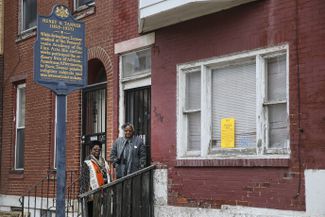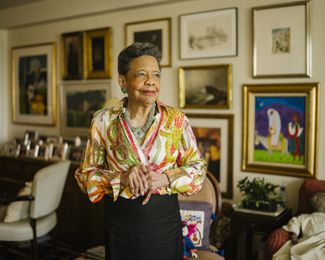

A Landmark's future
Rae Alexander-Minter knows exactly where Sand Dunes at Sunset, Atlantic City, a painting by her great-uncle Henry Ossawa Tanner, once hung in her family’s North Philadelphia home.
“I remember it so well,” she said of the painting, recalling its place in the library where her mother, the lawyer Sadie Tanner Mossell Alexander, saw clients.
The painting of wind-whipped dunes under a hazy sunset hangs today in the Green Room at the White House. It was the first painting by a Black artist to be part of the White House’s permanent collection.
Alexander-Minter is grateful to see the painting honored and preserved as part of American history. Now she wants the same for the North Philadelphia house where Tanner grew up and lived while studying at the Pennsylvania Academy of the Fine Arts. She was heartbroken to learn last year that the Diamond Street residence where her parents were married and many influential Black Philadelphians gathered had deteriorated so badly it could face demolition.
More From This Series
“It’s beyond the house,” Alexander-Minter said. “The house is a symbol of our African American history. It’s larger than just bricks and mortar.”
Alexander-Minter, now an anthropologist who lives in New York, grew up a mile from the Tanner House, which gained recognition as a National Historic Landmark in 1976.
Her great-uncle’s home looms large in family lore. She recalled stories of her mother making lunches for herself in the three-story rowhouse before heading off to the University of Pennsylvania, where she would eventually make history as the first African American to earn a Ph.D. in economics and, in 1927, the first Black woman to earn a law degree at Penn’s law school. Sadie Tanner Mossell Alexander followed in the footsteps of her father, Aaron Mossell, who was the first African American to graduate from the law school and came from a prominent family of Black professionals. But the lunch she carried from Tanner’s North Philadelphia home had to be eaten on the steps of College Hall because Black students still weren’t welcome in the university dining halls in the 1920s, Alexander-Minter said.
Make More Possible
Show your support and help our journalists continue to make important work like A More Perfect Union possible with a tax-deductible gift.
Support Independent Journalism
To support more Inquirer journalism, consider subscribing today.
The Tanner home became a nexus of Black achievement. One of Henry Tanner’s sisters, Dr. Halle Tanner Dillon Johnson, grew up to become the first woman licensed to practice medicine in Alabama. Booker T. Washington had recruited her to teach and start a nursing school at Tuskegee Institute. A generation later, in 1918, Sadie Tanner Mossell Alexander founded a chapter of the influential Delta Sigma Theta sorority at Penn and the sorors met at the house. Its address even served as the organization’s address for a time.

But by the time Alexander-Minter was growing up, the family had sold the house.
Lewis Tanner Moore, Alexander-Minter’s younger cousin, a retired Philadelphia Public Health Department administrator whose grandfather, Lewis Baxter Moore, was the first Black man to earn a doctorate of philosophy at Penn, has seen inside the Tanner House only once. It was more than 30 years ago, in 1991, when the Pennsylvania Historical and Museum Commission installed a sign in front of the landmark.
That was the same year a major retrospective of Tanner’s work was shown at the Philadelphia Museum of Art. Henry Tanner’s great-granddaughter was visiting from France and they wanted to see the house.
“The people who were renting it saw that we were interested and allowed us to walk through,” Moore said. At the time, the house was in fairly decent condition.
“I hope there’s a way to preserve it and to have it be something that is useful to the community and preserves our history. We need to ideally have something that celebrates the past and opens doors to the future.”
Alexander-Minter’s greatest wish is for the house to become a place for Philadelphians to learn about the things that gave her family a place in history.
“If it were a cultural center, there could be [programs for] dance, music, economics, and the law,” she said. “For little Black and brown children walking by it on their way to school, what would it mean to them if they knew this history?”
There are signs the vision could be realized. Jackie Wiggins, a retired teacher who conducts history tours, and Deborah Gary, president of the Society to Preserve Philadelphia African American Assets, were among the first to call attention to the deteriorating conditions at the Tanner House. “Our role is to help preserve the property to make sure it’s not demolished.” Gary said in a recent interview. A campaign spearheaded by their grassroots Friends of the Henry O. Tanner House group has raised nearly $26,000 and won the support of the Preservation Alliance of Greater Philadelphia; Michael Thornton, the current primary owner of the house; and the Philadelphia Museum of Art, which has pledged to donate to the campaign. PAFA, where Tanner studied art, has also voiced support for the effort.
Eric Pryor, PAFA’s president, only recently learned of the Tanner family’s place in African American history, beyond its most famous son.
“The power of the Tanner House for me is that the Tanner family was exceptional. And when you think of exceptionalism, or just excellence, it was pervasive in that family,” Pryor said in an interview with The Inquirer. “And to me, that’s a much more powerful story and why it’s so important for it to be saved and for that history not to be lost, because it’s the history of a family.”
The institution, he said, wants to be involved as part of a “collective effort.”
“It’s definitely not an effort that we could take on alone. Not in this moment, where we are in our own evolution,” he said. “What do they say in the airplane? Put on your own oxygen mask.”
Acknowledgement
A More Perfect Union is produced with support from The Lenfest Institute for Journalism, Lisa D. Kabnick and John H. McFadden, Peter and Judy Leone, and Surdna Foundation. Editorial content is created independently of the project’s donors.
Staff Contributors
- Reporter: Valerie Russ
- Contributing Editor: Errin Haines
- Deputy Editor: Ariella Cohen
- Research Director: Brenna Holland
- Managing Editor of Visuals: Danese Kenon
- Creative Direction and Development: Dain Saint
- Project Manager: Ann Hughes
- Digital Editor: Patricia Madej
- Audience: Erin Gavle
- Copy Editing: Richard Barron

